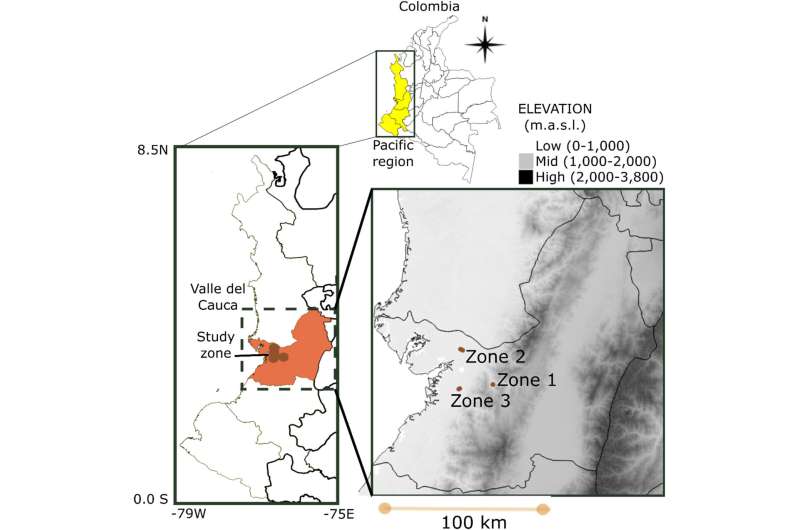This article has been reviewed according to Science X's editorial process and policies. Editors have highlighted the following attributes while ensuring the content's credibility:
fact-checked
peer-reviewed publication
proofread
'Tis the season to recognize chocolate: Researchers highlight high quality cacao in Colombia

Scientists are working to protect the unique qualities of cacao beans grown in the Buenaventura region on the Pacific coast of Colombia.
In a study published in the Journal of the Science of Food and Agriculture
, researchers from the Colombian Corporation for Agricultural Research (AGROSAVIA) have examined a wealth of metrics to uncover the complex interactions between
In a pioneering move, they have proposed that Buenaventura should be designated as a new Denomination of Origin (DO) for cacao trees. This is a legal recognition given to products that originate from a specific geographic region, which certifies their unique quality and characteristics.
The benefits of Buenaventura
The study, which is the first to scientifically document the unique properties of cacaos in Colombia, notes that Buenaventura stands out from other cacao-producing regions because of the distinctive fruity aroma of the cocoa derived from the area, attributed to the rich biodiversity of the lowland rainforest.
Colombia is recognized worldwide as a producer of cacao beans for fine-quality chocolate products. Despite this, a lack of scientific research to characterize its unique regional conditions and cocoa quality means Colombia lags behind in the realm of cacao DOs.
Sebastián Escobar Parra, an associate Ph.D. researcher at AGROSAVIA and co-author of the study, explained the significance of cacao DOs for a region. "Economically, it can lead to higher market prices for the region's cacao products, boosting local economies and providing financial incentives for farmers. Culturally, it preserves traditional knowledge and practices related to cacao cultivation, contributing to the cultural heritage of the region."
Importantly, establishing denominations of origin also promotes sustainable practices and the preservation of biodiversity in cacao production. Carlos E González-Orozco, an associate Ph.D. researcher at AGROSAVIA and corresponding author on the study, explained:
"Cacao denominations of origin play a vital role in promoting sustainable practices by emphasizing traditional farming methods, conserving native varieties, encouraging agroforestry, conserving water resources, promoting organic pest management, educating farmers, and aligning with certification standards. Through these efforts, denominations of origin contribute significantly to the preservation of biodiversity and the sustainable future of cacao production."
Characterizing the region
The study proposes a framework encompassing multiple variables that, when quantified, could collectively contribute to the establishment of cacao DOs. Among these are:
- Geography—conditions of the natural environment including soil composition, climate, and altitude.
- Genetics—the genetic diversity of cacao plants within a region can be used to identify characteristics contributing to distinct flavor profiles and disease resistance.
- Pests and Diseases—Understanding and managing region-specific pest and disease challenges are essential for sustaining cacao production and maintaining the unique qualities associated with denominations of origin.
- Microbial Diversity in the soil and on cacao pods—this can influence the fermentation process, a critical step in chocolate production. Unique microbial communities in a region contribute to the development of specific flavors during fermentation, impacting the final chocolate product.
- Cocoa Quality—flavor, aroma, texture, and chemical composition are all crucial factors in identifying superior quality cacao from specific regions.
Expanding the framework
The authors hope that this framework can be expanded to other regions of Colombia to provide cacao denominations of origin for the local farmers.
González-Orozco explained, "This scalability is invaluable, as it enables the establishment of denominations of origin not only in Colombia but also in other parts of the world. Consistent standards and recognition of regional uniqueness contribute to the global reputation of cocoa-producing regions."
"Future directions might also include studying the long-term economic and environmental sustainability of cacao cultivation in these designated regions," noted Parra.
More information: Carlos E González‐Orozco et al, Integrating new variables into a framework to support cacao denomination of origin: a case study in Southwest Colombia, Journal of the Science of Food and Agriculture (2023). DOI: 10.1002/jsfa.13016
Journal information: Journal of the Science of Food and Agriculture
Provided by Society of Chemical Industry




















